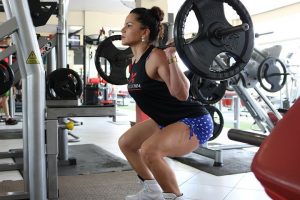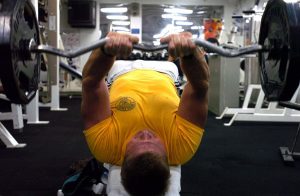When you first start training with weights, you have nowhere to go but up. Beginners who workout consistently typically see improvements with just a basic routine, but the more you train, the harder it becomes to make progress. You may be pleased that your muscles have definition and that your strength has improved, but when your strength gains hit a plateau, a strategy like a wave workout will help increase your muscle strength.
The Concept
Training for strength requires lifting heavier with fewer reps and getting more rest between sets during your workout. A 4-week wave workout is ideal for increasing strength because it requires you to increase the weight you lift while progressively decreasing your reps. You’ll rest longer than you’re probably accustomed to before and after your wave sets, and you’ll also allow your muscle groups to rest longer before working them again, too.
4-Week Gains
James Stoppani tells readers of the “Encyclopedia of Muscle and Strength” that the wave training method could boost their strength up to 10 percent over 6 to 8 weeks. And in the “Men’s Health Book of Muscle” Ian King and Lou Schuler note that strength increases are noticeable after just the first couple of workouts. How much your strength will increase after working a wave can vary. A lot will depend on your individual genetics. However, training consistently and getting sufficient rest between workouts will maximize the strength benefits that wave training can produce.
How to Implement Wave
To ensure you get a full body workout every week, yet still get enough rest between workouts, the “Men’s Health Home Workout Bible” recommends splitting your training into two workouts, an upper-body day and a lower-body day. You’ll schedule three workout days per week, leaving a minimum of one day for rest between each workout day. For example, you could workout Monday, Wednesday and Friday leaving Tuesday, Thursday, Saturday, and Sunday for rest days. Once you know what kind of split you’ll be working, it’s important that you not try to perform every exercise as a wave. Trying to do wave training throughout your entire routine every day is a formula for fast fatigue and burn out. Stack recommends picking one exercise each session to “wave.” Place your wave exercise at the beginning of your workout. If you try to do a wave in the middle or at the end of your session, you’ll already be fatigued and might not be able to lift as heavy as you need to to see optimal results from the technique.
Working a Wave Routine

Wave training gets you lifting more than usual right away putting you on your way to serious strength gains.
With a wave workout, you’ll do a group of warmup sets, or a wave, of each exercise followed by two to three waves of progressively increasing weights and progressively decreasing reps. For example, you’ll do your warmup wave starting out with 10 reps at 30 percent of your maximum weight, rest for 2 minutes, followed by 8 reps at 55 percent, rest for 2 minutes; finish with 5 reps at 75 percent. After a 4-minute rest, you’re ready to begin your first wave by starting out at 80 percent of your maximum weight for 8 reps. Rest for 4 minutes then increase the weight to 85 percent for 5 reps. After another 4-minute rest increase the weight to 90 percent and only complete 2 reps. You’ll be ready for wave number 2 after a 4 minute rest. You should still perform the descending reps 3, 2, and 1, but this time you’ll start out at about 83 percent of the maximum weight you can lift, then increase to 88 percent and finish with 92 to 93 percent. Your third wave will be even heavier: 85 percent, 90 percent, and finally 95 percent of your max weight. You should be able to get in at least two sets in your third wave. Try for 6 reps in the first set, 3 reps in the second set and 1 rep in the third set. It’s possible that you may only go to failure rather than completing all the reps in this last wave. Even if you’re only able to successfully complete the second wave, you’ll still be lifting more than usual and be on your way to serious strength gains.
Once you’ve done your wave exercise for the day, finish your workout with normal weight, sets, and reps with the rest of your exercises.
Take Care
Warming up before any weight lifting workout will help avoid injury; warmups are especially vital when you’re challenging your muscles to lift more than they’re used to lifting. The key to a successful wave workout is conservative increases. You should only increase the amount of weight for each wave by two to three percent, using only 30 percent of your maximum weight for your warmup and starting your first wave at 80 percent of your maximum. Additionally, you might want to alternate wave workouts with your normal routine to give your body a better chance to recover and minimize risk of injury. For example, you could make your first and third workouts in a three-day split wave workouts one week, then do a wave workout during your second workout the following week.


